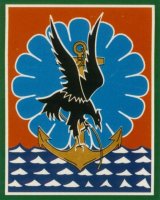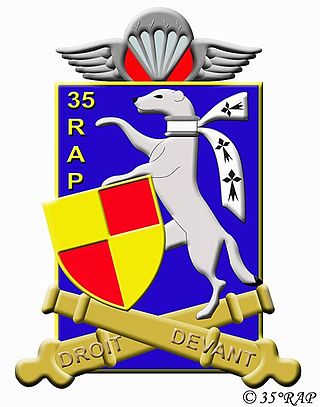
A paratrooper is a military parachutist—someone trained to parachute into a military operation, and usually functioning as part of airborne forces. Military parachutists (troops) and parachutes were first used on a large scale during World War II for troop distribution and transportation. Paratroopers are often used in surprise attacks, to seize strategic objectives such as airfields or bridges.

In military organizations, a pathfinder is a specialized soldier inserted or dropped into place in order to set up and operate drop zones, pickup zones, and helicopter landing sites for airborne operations, air resupply operations, or other air operations in support of the ground unit commander. Pathfinders first appeared in World War II, and continue to serve an important role in today's modern armed forces, providing commanders with the option of flexibly employing air assets. There was a group of pilots who were also designated pathfinders. They flew C-47 (DC-3) aircraft and were the lead planes followed by paratroop transports, used for dropping paratroopers into designate drop zones such as on D day, the Normandy Invasion.

A parachutist badge is a badge awarded by armed forces or paramilitary forces of many states to personnel who have received parachute training and completed the required number of jumps. It is difficult to assess which country was the first to introduce such an award.

The 2nd Foreign Parachute Regiment is the only airborne regiment of the Foreign Legion in the French Army. It is one of the four infantry regiments of the 11th Parachute Brigade and part of the spearhead of the French rapid reaction force.

The 1st Marine Infantry Parachute Regiment or 1er RPIMa is a unit of the French Army Special Forces Command, therefore part of the Special Operations Command.

The 2nd Marine Infantry Parachute Regiment is an airborne regiment of the Troupes de Marine created in 1947. The regiment is heir to the traditions of the 2nd Colonial Commando Parachute Battalion 2eB.C.C.P. As of 2008, the regiment is stationed at Saint-Pierre, Réunion.

The 3rd Marine Infantry Parachute Regiment is one of the airborne force regiments of the Troupes de Marine. It is heir to the 3rd Colonial Commando Parachute Battalion created in 1948 and the 3rd Colonial Parachute Regiment. The regiment is part of the 11th Parachute Brigade.

The 11th Parachute Brigade is one of the French Army's airborne forces brigade, predominantly light infantry, part of the French paratrooper units and specialized in air assault, airborne operations, combined arms, and commando style raids. The brigade's primary vocation is to project in emergency in order to contribute a first response to a situational crisis. An elite unit of the French Army, the brigade is commanded by a général de brigade with headquarters in Balma near Toulouse. The brigade's soldiers and airborne Marines wear the red beret (amaranth) except for the Legionnaires of the 2ème REP who wear the green beret.

The 1st Parachute Hussar Regiment is an airborne cavalry unit in the French Army, founded in 1720 by Hungarian noble Ladislas Ignace de Bercheny. It is stationed in Tarbes and is a part of the 11th Parachute Brigade.

The 6th Marine Infantry Parachute Regiment is an airborne infantry unit of the French Army.

The 8th Marine Infantry Parachute Regiment is an airborne regiment of the Troupes de Marine. The 8e RPIMa was created on 28 February 1951 and the men wear the red beret. It is part of the 11th Parachute Brigade.
The École des troupes aéroportées (ETAP), or School of Airborne Troops, is a military school dedicated to training the military paratroopers of the French army. It was established in 1964 and is located in the town of Pau, in the département of Pyrénées-Atlantiques, France.

The 35th Parachute Artillery Regiment is the only airborne artillery unit of the French Army forming the air artillery component of the 11th Parachute Brigade. It is based in Tarbes together with the air cavalry, the 1st Parachute Hussar Regiment.

The 17th Parachute Engineer Regiment is heir to the traditions of the 17th Colonial Engineer Regiment which fought illustriously during the Second World War. It is the only airborne engineer unit of the French Army forming the engineering component of the 11th Parachute Brigade and secures all the specific airborne engineering missions relative to para assaulting at the level of deep reconnaissance as well as operations relative to para demining and handling explosives. The regiment has been present non-stop since 1975 on all theatres of operations. For its various combat operational deployments, the 17e RGP was cited 3 times at the orders of the armed forces, 2 times at the orders of the armed forces corps, and three of its combat companies cited at the orders of the armed forces in addition to armed forces corps.

The Portuguese Paratroopers are an elite infantry assault force, representing the bulk of the airborne forces of Portugal. They were created in 1956 as part of the Portuguese Air Force, being transferred to the Portuguese Army in 1993. Presently, most of the Paratroopers are part of the Portuguese Rapid Reaction Brigade which comprises all 3 special forces troops.

The 25th Parachute Division was an airborne division of the French Army, part of the French Airborne Units. Consisting mainly of air infantry specialized in airborne combat, air assault and established in 1956; the Parachute Division took principal part only in the Algerian War.
Colonel Frédéric Cyrille Jules (Fred) Geille was a French military officer. Frédéric was the 1st French paratrooper and a Fighter pilot of the French Air Force as well as a commander and founder of various units and initiatives. He is also considered as the Father of French paratroopers and the inventor of French High-Altitude Operational Jumpers.
This page is based on this
Wikipedia article Text is available under the
CC BY-SA 4.0 license; additional terms may apply.
Images, videos and audio are available under their respective licenses.















